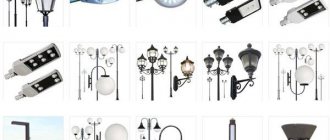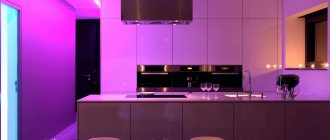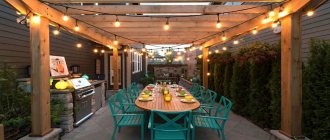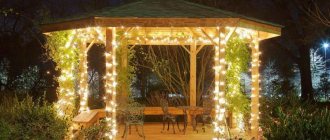How to make LED lighting for balconies with your own hands
When the renovation of the house has already been completed, you can turn your attention to improving the balcony or loggia.
Many people here prefer to do the finishing themselves. When that is completed, it’s time to think about how to organize decent lighting here. For many, the LED strip has become a real find. By correctly installing lighting on your balcony or loggia using an LED strip, you will add another room to your apartment in which you will enjoy spending time. And all this can be done with your own hands.
Primary requirements
Since at the stage of construction and commissioning in houses they do not even lay power supply lines on the balcony, the laying of wires and planning the location of lighting fixtures falls entirely on you. Since the climatic parameters on the balcony can differ significantly from those in the interior, the operating conditions for electrical equipment here will be relatively harsh.
Due to the danger of a combination of electricity, temperature changes and moisture, when designing and installing lighting on a balcony, a number of requirements and rules should be taken into account:
Thanks to the development and implementation of modern technologies, a huge range of lighting devices allows you to use various types of lighting on your balcony, which you can use either individually or in combination.
Features of the room
Loggia and balcony are often used by people as warehouses for a variety of things. But if you gather your strength here, you can completely redo everything with your own hands so that you can spend warm summer evenings here with pleasure. And good lighting is not the last place in this matter. With this approach, it is necessary to take into account several requirements that apply to lighting fixtures on a balcony or loggia:
- protection from moisture. Very often there is no heating here, so when organizing lighting using an LED strip, you need to choose its moisture-proof versions;
Note! The tape must be protected from moisture, regardless of where it will be located: on the ceiling (plasterboard or tension type), under the railing or on the floor.
- protection from dirt and dust. The balcony and loggia always have wide windows, which are often open during the warm season. Therefore, it is necessary to protect the lamps from possible contamination.
This is where the main features of the premises end.
Types of lighting
There are several types of lighting fixtures that can be installed on the balcony.
Natural light
The simplest and most affordable option. It is better to use it if the glazing area is large enough (for example, with panoramic glazing) and there is a lot of sunlight, as well as on open balconies.
The advantages of this option include the absence of additional financial costs. The disadvantage is obvious: the loggia will not be illuminated in the evening and at night.
Ceiling lamps
One of the most common lighting options. Depending on the size of the balcony and the need for lighting, you can install from 2 to 6-8 lamps.
There are 2 types of ceiling lights:
- pendant: these are chandeliers that hang from the ceiling on a cord. When choosing, you should pay attention to the size of the lamps: a chandelier that is too large for the balcony will look ugly and take up a lot of space;
- spot: mounted in a suspended ceiling. The lamps can be static or rotating; the second option allows you to direct the light in the desired direction. The advantages of such lamps include their versatility and small size, the disadvantages are some difficulties in removal.
Let's talk about LED strips
Combined balcony lighting
Today, LED strip is a common lighting device that can be used to create a wide variety of types of lighting in any room of the house. Very often it is used to create hidden lighting for ceilings, especially suspended or plasterboard ones.
Note! Very often, LED strips are used in tandem with other types of lighting fixtures. This combination is often found on balconies and loggias.
LED lamp has many advantages:
- quick and easy installation. On the back of the tape there is a self-adhesive base, which makes it possible to install the lamp on any surface in a matter of minutes;
Note! To connect the LED strip, you need a power supply. And if you want to be able to estimate the color mode of the glow, then you will also need a controller with a remote control.
- a great way to decorate a room;
- significant product flexibility;
- high-quality luminous flux, thanks to which the lighting of walls or ceilings is complete;
- Can be installed on any type of ceiling. Often used for stretch and plasterboard ceilings;
- presence of a wide variety of colors. You can use both single and multi-color ribbons.
In addition, with the help of such a lighting product you can create lighting both around the perimeter of the room and local (in certain areas of it). On a balcony or loggia using LED you can make the following types of lighting with your own hands:
- are common. Here it is assumed that the light source will be placed around the entire perimeter. This option is great for the ceiling;
- local. For example, you can install the product under the railing. As a result, the light will beautifully flood the lower part of the room;
Local lighting of the balcony with tape
- decorative. This involves highlighting certain decorative elements. For example, such a tape can illuminate shelves, paintings or the bottom of furniture placed on a loggia or balcony;
- combined. This is the most common lighting option used on balconies. Here, LED lighting can be combined with spotlights from a suspended stretch or plasterboard ceiling.
At the same time, the LED strip is so easy to use that almost anyone can install it with their own hands, even if they have little knowledge of electronics. Which option for lighting a balcony using an LED strip you choose depends only on your preferences and the characteristics of the room itself.
LED lights. LED strips for ceiling lighting
During renovations, special attention is paid to lighting, which, as you know, sets the basic atmosphere for each room. Along with the rapid development of energy-saving technologies, the use of diode lamps is increasing, which can significantly reduce energy consumption. LED strips are distinguished by a combination of practicality and attractive design. They are attached directly to the ceiling and create even, soft lighting.
LED strips for ceiling lighting
What are the devices
LED ceiling lighting
LED strip SMD 3528
In addition to the luminous elements, the tape contains resistors that protect the entire system from high voltage and limit the flow of current.
LED strip structure diagram
Table. Types of LED strips.
| Characteristic | Varieties |
| Diode type | 1. SMD 3028. 2. SMD 5050. Diameter affects coverage area. |
| Fixation method | 1. Self-adhesive with a reliable adhesive layer. 2. Attached with plastic brackets. |
| Tightness | 1. Without sealant, used in ordinary rooms. 2. Medium protection from water, can be used next to the sink or in the bathroom. 3. Sealed, able to function under water. |
| LED color | 1. White tape. 2. RGB. |
Types of LEDs on LED strips
Types of LED strips
RGB tape
Product benefits
The main advantages of LED strips include:
- saving electricity;
- uniform and directional lighting;
- service life reaching 10 years;
- the ability to choose different colors;
- in multi-color ribbons - stable color throughout the entire service life;
- flexibility, allowing you to give the tape any shape;
- environmental friendliness and fire safety due to the absence of mercury and low heating;
- possibility of adjusting the length of the tape;
- no influence on TV signals due to the absence of interference.
LED strip power
Due to these qualities, diode strip is often used not only for additional lighting, but also as the main light source. At the same time, the energy consumption of 10 meters of such a strip will be even less than that of an incandescent lamp that is familiar to many.
What does an LED strip look like in the interior?
Selection of tape by diode type
The most common diodes for such tapes are SMD 3028 and SMD 5050. They are mounted directly on the surface of the tape and vary in size, as indicated by the numbers in the name. In terms of brightness, small SMD 3028 diodes are not inferior to large ones, but due to their small sizes they can illuminate a smaller ceiling area. Therefore, to create a brighter backlight, you should choose SMD 5050.
As for the color parameter, it is worth paying attention to the crystals used in LEDs.
Prices for LED strip
LED Strip Light
Color samples
There are currently 4 options available:
- yellow;
- red;
- blue;
- green.
White crystals are not currently produced. Instead, the design uses a blue element that emits ultraviolet light. Since the diode is coated with a phosphor that glows when exposed to such rays, the output is white light.
LED Strip Light
But such a solution to the issue negatively affects the quality of the tape. It is the most short-lived due to the rapid burnout of the phosphor. The result is not only a decrease in the brightness of the tape, but also the appearance of a blue glow.
The classic RGB combination, in turn, allows you to get more than just one of the three colors offered. As is known from optics, white color is obtained by mixing all three colors. In combination with the stable operation of crystals that do not require additional coatings, this significantly increases the service life of the product. Typically, such tapes come complete with a remote control, which is used to adjust the lighting. This provides additional opportunities for experimentation.
Tips for choosing LED strip for different rooms
Depending on where the ceiling lighting is planned to be installed, the type of product and its placement are selected. The brightness changes due to variations in the number of diodes within one meter of tape. The more lighting elements, the brighter and more expensive it is.
One meter of tape may have a different number of diodes
Number of LEDs on strip
In the corridor
Since this area does not require stable bright lighting, purchasing a strip with SDM 5050 or higher diodes will be impractical. Mostly corridors and walk-through areas need additional light at night. Using incandescent lamps will lead to high energy costs, and darkness is not a good solution. The best option would be to install low power LED strips. Their light will not irritate the eyes at night, and using a dimmer you can change the brightness, which will also have a positive effect on the family budget.
Color design
LED products, as noted above, have a wide variety of colors. For balcony lighting, it is recommended to use the following colors:
Colored loggia lighting
You can also use RGB strips, which will allow you to get a huge number of shades of any colors using the controller. In addition, such a system will work in several modes (color change, fading, and others). It is necessary to choose the color of the glow based on the finishing available in the room, as well as your preference. All the colors listed above will create a comfortable and cozy atmosphere. You can also organize a romantic or fairy-tale atmosphere, depending on the need and the created surroundings using special decorative elements of interior decoration.
LED strip for the window. Options for lighting curtains with diodes
The LED window curtain garland has 2 types of glow: end and side. It is compact, thanks to this property it can be installed even in very narrow window openings. In addition, the tape is practically invisible when turned off.
Ideally, residents should not observe the glow provided by the operation of LEDs, but rather diffused (reflected) light that is pleasant to the eye.
Scattered (reflected) light
It is advisable to hide the cornice for such curtains in the ceiling niche or cover it on top with a polyurethane cornice so that the light source is hidden.
Decorative lighting of curtains with diodes is performed in 2 options:
- Below the curtains.
- On top of the curtains.
The most common way of illumination is from the top of the curtains, pointing down onto the fabric. To do this, a box is mounted near the edge of the curtain; a diode strip is placed in it, which supplies light tangentially.
Sometimes, to get a bright accent of light, it is enough to illuminate not the entire curtain, but only the lambrequin, which in the light of the diodes acquires a unique aura.
In some cases, LED curtain lighting is not hidden in a box, but is used to illuminate blinds. To do this, choose a tape with the most dense arrangement of diodes to create an interesting point-light decor.
Hypodynamic interior lighting is provided by full-color RGB diodes, which are controlled using a remote control and can change the shades of light. After pressing the control button, the tape takes on the selected static color, which can completely change the visualization of the curtains. If blue curtains are illuminated with yellow diodes, you will get diffused greenish illumination for the curtains, and if blue diodes are directed at red textiles, the curtain illumination will be purple.
Low-power diodes turn transparent fabrics into light and weightless ones. The lower the density of the diodes, the more airy the organza tulle, muslin or thin curtain will look.
For thick and heavy curtains, more powerful and closely spaced diodes are often used, because such textiles transmit little light and therefore require stronger lighting.
How to install?
Places for cutting
Once you have decided which method of lighting a balcony or loggia is most suitable for you, you can begin installing the LED strip with your own hands. Here you will not need any special tools or additional materials, and the installation itself will take a minimum of time and effort. Installation will be carried out as follows:
- Determine the length of the LED strip and cut it off from the main skein. The incision site is marked with a picture of scissors;
Note! Today, LED products are sold in skeins of several meters. The skein should be cut only in special places. Otherwise you will damage the product.
- after all the pieces have been cut, you need to solder them together and with the wires with which they will be connected to the power supply. The wires should be soldered to special contact pads located at the edges of the cuts. All elements of the lighting system should be assembled according to the diagram shown below;
Diode strip connection diagram
- All wire soldering areas must be well cleaned and insulated.
When the entire system is assembled, you can begin installing the LED strip at a permanent location. To ensure that the backlight holds tightly and does not fall off over time, before gluing it, all dirt must be removed from the surface and degreased with alcohol. Next, we tear off the paper tape from the back side that protected the sticky part and carefully apply it to the surface. We even out any possible curvatures and run it with our palm so that the strip sticks to the surface as tightly as possible.
Tools and materials
In order for the window to sparkle with light in the dark, you will need the following materials:
There are 12 and 24 V varieties of backlight strips on sale. Professionals usually prefer more powerful ones; a novice electrician will only need to pay attention to the price and color.
The tape cannot be plugged straight into an outlet, as it is designed for direct current. A power supply is required. If the LEDs light up in different colors, then a controller will also be needed. It is recommended to mount powerful current sources in an aluminum rail profile for cooling.
Tools you will need:
Lighting on the loggia and balcony: do it yourself
Thanks to the use of various finishing options, the balcony can be turned into a cozy and stylish room. But in addition to the finishing solution, it is necessary to decide on many other issues, such as organizing good light on the balcony or loggia. Only with good light will a balcony become a full-fledged room in the house. But how to make balcony lighting with your own hands?
There are many design decisions that affect lighting. The main thing is that the lighting is in harmony with the texture and shades of the finish. For safety, the wiring must be done perfectly. What lighting options are there?
Photos of lighting designs
As a rule, most apartments in Russia do not have power supply on their balconies or loggias. In this regard, the owners of such housing have a question: how to install lighting. To carry out such work, at least minimal electrical installation experience is required. Also, do not forget that the balcony is an area of particular difficulty, which means that maximum effort and scrupulousness should be applied to this type of work.
To install high-quality and competent lighting on the balcony, the following preparation is required:
- Project for the location of lamps.
- Exiting electrical wiring from the apartment.
But before this, it is necessary to analyze the indicators of the electrical network already existing in the apartment in order to understand whether it is possible to additionally connect consumers to it. What is included in this analysis:
- determining the condition of the current electrical wiring so that there are no twists or destruction of the conductor insulation;
- check whether the electrical protection in the distribution panel is working;
- calculate the load on the entire line taking into account the added power. Based on the identified indicator, it will become clear whether such a load is possible and whether it does not exceed the permissible standards for the cross-section of already installed conductors.
Having received all the necessary values, it will be possible to determine the possibility of installing a future electrical network for the balcony from an existing electrical distribution or from a distribution panel.
The most optimal solution is the second option, since in this case an individual line with good protection will be used. However, to implement this idea, significant financial investments will be required. It is for this reason that the majority of residents prefer to direct light onto the balcony from the nearest electrical outlet.
To connect the light from the socket, you need to do the following:
- Create a channel for laying the wire from the outlet.
- In the place where the wire will go out onto the balcony, you should drill through the wall.
- Next, a hole for the socket is hollowed out using a hammer drill.
- Then a two- or three-wire wire is connected to the wires of the socket, which is located in the apartment, and led to the balcony. In a pre-prepared channel, the wire is secured with staples. It is recommended to use wire in black insulation, as it is of higher quality and more reliable. It is also worth paying attention to the wiring - whether it is copper or aluminum and take this into account.
- A special box is inserted into the hole from the apartment to the balcony, through which a wire is threaded and connected to the outlet. The socket, in turn, is fixed into a previously installed box.
- Using putty, the channel with the wire in the apartment is covered.
- After all the work has been done, all that remains is to install the lamp and connect it to the outlet.
Using lamps on the balcony
Lamp is a broad concept. It includes not only ceiling lighting, but also other types. In addition to their immediate purpose, lamps are designed to emphasize functionality and style.
Lighting can be general, local, decorative, combined, exposure or indicative. As for the installation method, the following lamps are distinguished:
Using sconces on the balcony
They create an unusual diffused light coming from the side. In the relaxation area, sconces look great. They are attached above the chair. This job is so simple that you can do it yourself. The disadvantage of this option is the relatively small flow of light. In such lamps you can use no more than two light bulbs.
Sconces on the balcony as lamps
Using LED lamps on the balcony
Previously, they were practically not used on balconies and loggias. Today, this is one of the most versatile and inexpensive methods of lighting, allowing you to implement a variety of design ideas on the balcony. The disadvantages of this type of lighting include only the increased cost compared to most other lighting devices, even if the same level of illumination is provided.
This option is quite compact and highly elastic. If you decide to organize lighting on the loggia, the photo below shows how the LED strip is mounted. It can be installed in almost any interior item.
Installing LED lighting on the balcony with your own hands
Using Spot Lighting
Typically used as overhead light. It allows not only to organize general diffused light, but also harmonizes with local and exposure lighting. But this lighting option also has its drawbacks. So, if you push a powerful light bulb too deep into the ceiling, the lamp may overheat. This will not only damage the lighting fixture, but will also damage the finishing coating of the ceiling.
Types of lighting
Lighting on the balcony using lamps
The concept of “lamp” is quite broad and implies not only a lighting fixture on the ceiling. In addition to its direct purpose - lighting the balcony, the lamp should emphasize a functional and stylistic solution.
Stylish lighting on the balcony. The photo proves that it is not necessary to hang a chandelier on the ceiling
Depending on the type of lighting, balcony lamps are of general, local, decorative, combined, orientation, exhibition and decorative types.
According to the installation method, lamps can be ceiling, pendant, wall and table.
Lighting on the balcony using sconces
This type of lighting provides good diffused side light. The sconce is perfect for a relaxation area. It’s not difficult to mount it on the wall above a sofa or chair with your own hands.
The disadvantage of sconces is the relatively small luminous flux. The luminaires are designed for a maximum of two lamps.
Balcony lighting using LED strips
Just a few years ago, LED balcony lighting was practically not used as lighting. Today it is an economical and versatile type of balcony lighting, which makes it easy to implement a variety of design ideas.
The disadvantages of LED strips include their higher cost compared to other types with equal lighting intensity.
This backlight is compact and has good elasticity. The photo shows how you can integrate an LED strip into any interior elements.
Lighting on the balcony using spotlights
Balcony spotlights are used as overhead lighting. It makes it possible to create general diffused light and harmonizes with local or exposure lighting of the balcony.
Among the disadvantages, it should be noted that the lamp overheats if the bulb of the maximum permissible power is too deep into the ceiling. This leads to damage to both the lamp and the ceiling finish .
Features of organizing lighting on the balcony
If you are interested in how to install light on a balcony with your own hands, the video accompanying the article will help you familiarize yourself with the process. First of all, it is necessary to lay reliable wiring. There are two main wiring options - open and hidden.
Lighting in the arch between the room and the balcony
Open wiring is laid along the wall in a specialized box. You can also use a protective corrugated sleeve. As for hidden wiring, it is laid in the ceiling or wall. Often it is laid behind the casing.
Features of open wiring
This wiring option is laid directly on the surface of the ceiling and walls. This wiring option has several important advantages:
- convenient installation, you will not need to punch grooves in the walls and seal them in the future;
- ease of repair work: all communication elements remain open, ensuring constant and easy access to them.
But open wiring has one significant drawback. It is difficult to use on the balcony, because it does not combine with almost any design solution.
Features of hidden electrical wiring
As a rule, hidden wiring is used in apartment conditions. This option has one significant advantage - invisibility. For this reason, on a balcony it is better to organize hidden electrical wiring. The choice of wiring method is determined by the chosen method of finishing the ceiling and walls.
Balcony lighting option
If you look at the interiors of loggias and balconies, it becomes clear that along with plaster on the walls, only hidden wiring is used. At the same time, it is laid in pre-created furrows called grooves. It is necessary to carry out the following sequence of actions:
- marking of the future placement of lamps and distribution boxes, switches and sockets is carried out;
- purchase cables of the required length with a suitable cross-section;
- using a hammer drill and a grinder, grooves are made in the surfaces of the walls and ceilings into which the cable is laid;
- the grooves are sealed with alabaster;
- carry out high-quality insulation of the connection in the distribution box;
- all newly laid wiring is connected to electricity; if you do not plan a high load of electrical appliances on the balcony, then you can connect it to the light wiring of the apartment;
- connect and install lamps, sockets and switches.
It is important to carry out work when the power is turned off. The phase wire is connected through the switch “for break”. Otherwise, when changing light bulbs, you may get an electric shock even with the switch off.
Wiring installation diagram
How to choose a power supply for equipment?
In modern houses, many projects include lighting on the balcony, but in most cases, residents will have to do their own electrical wiring and install electrical equipment. Experts offer three possible solutions where you can get electricity for a balcony or loggia without spoiling the design of the apartment:
- A complex solution that requires expense and special tools is to run wires from the electrical panel on the staircase. This option is suitable in a situation where you have just received an apartment and work is underway throughout the house to improve the living space. The advantage of this method is that you can separately connect the loggia.
View of the equipped loggia
- From the distribution box in the next room. This option is best suited for solving the issue of lighting on the balcony, but it is necessary to take into account the cross-section of the wires installed and not to overload the group of consumers with additional powerful equipment.
Power supply from box
- A simple solution for obtaining power for lamps on the balcony is an outlet in the next room; it is almost similar to the connection option from the box, but is more economical, and you can also choose the nearest outlet.
What lighting options are available?
Each work begins with action planning, and an important place in this process is occupied by the choice of lighting equipment; lighting on the balcony must be made according to the intended purpose of this area. In general, most people make this space an additional place to relax, a kind of cozy corner. Designers offer several original ideas for organizing space lighting:
- lighting using sconces, great for creating different options for relaxation space;
Wall lamp for street lamp
- lighting the space using a floor lamp, which is installed next to the reading corner;
- the use of spotlights in lighting the space, they can create a romantic atmosphere; you can adjust the lighting by zone using diffused, soft light lamps;
Spot lighting on a closed balcony
- An excellent solution to the issues of creating coziness on a balcony or loggia is an installed chandelier with a wall mounting option in combination with a floor lamp and a table lamp with a fabric lampshade.
What order of work should I choose?
You need to understand that you do most of the work on installing balcony lighting yourself, and for this you need to have a clear action plan, which has already been systematized by many specialists, and which can be suitable for many repair options:
- to carry out work on connecting the laid wire, the apartment must be de-energized on the staircase, in the electrical panel;
- prepare the required footage of wire of the required cross-section and grade (copper or aluminum conductor);
- mark the route along which further grooves will be made;
- perform grooves, and also use a crown to determine the installation locations of sockets and switches if they are hidden;
- using a hammer drill, make a hole in the wall for the power cable; you need a drill of a certain diameter with a Pobedit tip;
- place the wire or cable in the grooves, secure it after 150–200 millimeters with alabaster or a spacer along the width of the groove;
- install all electrical equipment and connect it;
- check with the device the correctness and integrity of the assembled circuit;
- connect the power wire to the voltage source;
- carry out a test run.
Important! There is always moisture on the balcony in greater quantities than in the rooms of the apartment, for this reason it is recommended to choose waterproof lamps; experts also recommend using copper wire with a cross-section of at least 2 square millimeters in the gasket from the switchboard.
Which wiring is better?
What type of electrical wiring is best to choose when lighting on the balcony depends on how you want to organize the space, whether it is possible to make hidden wiring when it can be hidden under the final decoration of the room.
In the case where the balcony is not insulated, not glazed and has a concrete ceiling surface and concrete load-bearing walls around the perimeter, experts recommend making hidden wiring using grooves. In this case, no wires are visible and you can design the interior of the balcony at your own discretion. It should be noted that gating is an energy-intensive and effort-consuming method of laying wires, but in this case the design of the room is not disrupted.
How to lay wiring under the casing
This is a compromise method of wiring that can be implemented for lighting on a balcony. In this case, electricity is laid under the casing. This method of electrical wiring is applicable if you are using cladding with a frame. It has no significant disadvantages; rather, on the contrary, it combines the advantages of hidden and open wiring.
To install wiring in this way, you do not have to make grooves. The wires will not spoil the interior design. But you will have to lay the wiring in a protective corrugated sleeve made of plastic. This is necessary for additional insulation of wires and safety during operation.
How to do the wiring?
To organize lighting on the balcony, first of all, you need to lay the wiring. You can do this work yourself; first you need to get acquainted with the rules for doing it. The wires can be laid on the surface or in the recesses of the walls.
Hidden gasket
This option can be used on loggias and glazed balconies, regardless of the presence of insulation. Wires are laid before finishing is completed. Work order:
- grooves are made in the walls - recesses into which the wire will be laid;
- wiring is being installed, the wires are laid in protective corrugated tubes;
- The grooves are closed from above using putty, then finishing work can be done.
Open gasket
External wiring can be used on glazed and insulated balconies and loggias. The advantage of this option is that the process is less labor intensive. The downside is less aesthetic appeal. To carry out external wiring you will need:
- cable channels, that is, protective corrugated tubes for laying wires;
- Mounting boxes are places where wires are connected.
Advice! For installation on balconies, it is important to choose dust- and waterproof mounting boxes.
The work goes like this:
- the locations of lamps, sockets, switches are outlined;
- cable ducts are fastened and wires are laid in them;
- connection to the nearest outlet located in the room or to the distribution panel. It is necessary to draw a separate line to the panel if the load is large, for example, it is planned to install a microwave oven or electric kettle on the balcony. If the room will be equipped with 1-2 lamps, then you can connect the wire to the outlet.
So, lighting on the balcony can be organized in different ways. The choice of lamps is made depending on the purposes for which the balcony will be used. If this is a recreation area, then it is better to prefer diffused lighting; for a work room, directional light is needed. If you plan to carry out electrical work yourself, you will need to familiarize yourself with fire safety rules in advance.
Source: pobalkonam.ru
Lighting on balconies and loggias
In principle, you don’t need much to illuminate a balcony or loggia: its area is usually small, one or two light sources are enough. Today we will tell you how to choose them wisely.
Lighting for an enclosed balcony or loggia
Wall lights
In his project, Legko.com designer Andrey used a wall lamp to illuminate a cozy reading corner
Sconces and wall lamps are the most commonly used light sources for a balcony. A couple of small lamps will do a great job of illuminating a small space. In addition, attaching the sconce to the wall does not cause any particular difficulties, so you can do it yourself. An original solution for lighting an insulated balcony can be a garland of ordinary or LED lamps mounted on a load-bearing wall.
Ceiling lamps
Ceiling lamps, including spotlights, require more installation costs: for them it is necessary to prepare mounts on the ceiling, and for spotlights, you also need to organize a false ceiling behind which the wiring will be hidden. The balcony ceiling in this case is made of plasterboard or wood.
Large chandeliers or lamps hanging from the ceiling will visually hide the already small space of the balcony. But if you have a huge loggia, such lamps, on the contrary, can become an interesting accent in the interior. A good option is spot lamps that can be directed in different directions. Using one such ceiling or wall chandelier, you can organize lighting for all areas of the balcony at once.
3. Table lamps
Turning a balcony into a cozy office, reading corner or place for handicrafts is the dream of many. In this case, in addition to the main lighting, do not forget about local light sources. It is most convenient to use table lamps: they can be placed directly on the desktop, plus, they do not require additional communications. Work and read in comfort!
4. Fluorescent lamps
Bright fluorescent tube lamps (fluorescent lamps) will do a good job of lighting the balcony. They are mounted on the wall or ceiling. They are suitable for technological and minimalist design, for example, for high-tech interiors. In addition, if your balcony is a winter garden or greenhouse, fluorescent lamps will create the illumination necessary for plants.
LEDs
The recently fashionable LED strips are excellent for lighting indoor, warm balconies. You can place the tape around the perimeter of the balcony ceiling, or you can hide it under the railing, creating a kind of backdrop diffused light, as in the photo above.
Types of lighting
Balcony lighting is possible from the following sources:
- natural light;
- ceiling lamps;
- table lamps;
- fluorescent lamps;
- wall sconces;
- LED lights.
Natural light
Due to the large glass area, good lighting can be achieved without the use of electrical energy. Particularly high-quality natural light is obtained when using panoramic glass.
Ceiling lamps
Very often, when organizing lighting in a balcony, traditional ceiling lamps are used. Both pendant devices and spotlights are used.
Spot lamps are called lamps installed in suspended ceilings. There is a large selection of lighting devices of this kind: these can be either lamps with static bulbs or devices with rotating mechanisms. Rotary devices are good because it is possible to redirect the lighting to different areas of the balcony - depending on the needs at the moment.
A suspended ceiling typically has 4-6 lights connected to a double switch. Due to this organization of light, it becomes possible to connect from 2 to 6 light sources simultaneously.
Chandeliers are often used as a light source. However, when choosing this type of device, you should take into account the specifics of the balcony, since space is limited and a bulky crystal chandelier will look out of place.
Desk lamp
Table-type lamps are divided into stationary and mobile. There are systems equipped with a lever system, which makes it possible to change the direction of light in the desired direction.
Wall sconces
Sconces look impressive when decorating a balcony. The light from the sconce allows you to create a comfortable, cozy atmosphere on the balcony. Typically, such lamps are placed at a low height from the floor. The light is turned on and off using a chain or cord.
Fluorescent lamps
Such lighting is mounted in the ceiling space or on the walls. The power of daylight lamps varies widely and can be selected depending on the volume of the balcony room.
Artificial daylight is especially relevant for indoor plants in the winter, when it gets dark quickly. In this regard, daylight is used when creating greenhouses on balconies.
LEDs
LED strips are increasingly used to illuminate balconies. The lighting device is a strip on which LED elements are fixed. The tape is equipped with an adhesive surface, so the light source can be placed almost anywhere.
LED strips operate from 12-volt transformers or from a stationary electrical network. From a fire safety point of view, tapes powered directly from a 220-volt power supply are safer.
Open balcony lighting
If the balcony is open or not insulated, the choice is narrowed down to street lighting fixtures that are not afraid of low temperatures, dust, rain, snow and wind. These include wall lanterns, dust- and waterproof designs, as well as luminaires with a high degree of climate protection.
Balcony lighting without wiring
If you don’t want to waste time, effort and money on wiring, organize lighting using battery-powered LED lamps. LED lamps consume a small amount of electricity while producing fairly strong light. Since you will not use balcony lighting as often as regular room lighting, the battery life will last for a long time.
Installation instructions
If you managed to buy an assembled LED strip with connected wires, then the task is simplified. Otherwise, the order of work will be as follows:
It is better to provide an inconspicuous corner for the power supply, hide it behind a curtain or furniture.
If everything was done correctly, after connecting to the network you will be able to enjoy soft diffused light in the area of the window opening.
Source
Wiring Tips
- The first and most important tip: if you have never conducted electricity, seek help from a professional
- All the work that you carry out on the balcony falls into the category of reconstruction or even redevelopment. This means that their implementation requires appropriate permission and subsequent approval by architectural and operational authorities
- Wiring on the balcony must be done with double insulated cables. When installing external wiring on open and “cold” glazed balconies, the cable must additionally be placed in special corrugated tubes. Electrical equipment protection class - at least IP 44
- In order not to complicate your life, balcony lighting needs to be thought out in advance - before insulation, cladding and arrangement
- Decide in advance on the function of the room. There is a big difference between lighting a study room and a winter garden
- Before starting work, be sure to draw a diagram of the future wiring: where the energy-consuming devices will be located, how much power will be needed for their operation, etc.
- Open wiring is easier to do than closed wiring, but it looks less aesthetically pleasing. This option is good if you plan to cover the balcony with panels behind which you can hide unattractive communications
As you can see, lighting a balcony is not such a simple matter. You need to have certain knowledge and skills to carry out all the necessary communications here. If you feel that you have the necessary competencies, all that remains is to choose the type of lighting and get down to business. If not, it’s better to seek help from a professional and just enjoy the result.
DIY lighting on the balcony
Lighting on the balcony and its installation is one of the stages of its arrangement. When choosing a suitable option, you need to consider the following points: what will the balcony be used for? For example, in the office, the lighting should be bright enough, especially if you are supposed to work at a computer or read printed materials and manuals.
For a guest or recreation area, dim lighting and soft lamps are suitable. If it is planned to equip a flower gallery there, then it is necessary to take into account the characteristics of the plants being grown and their lighting needs.
You also need to decide on the wiring diagram. In this regard, there are two main options:
- open wiring;
- hidden wiring.
The first option is simpler to implement and provide light on the balcony, but still a closed scheme is preferable for living space.
Step-by-step instruction
If you are going to do the balcony lighting yourself, you must follow the established sequence of actions - prepare the place for laying the wires, mount all the circuit elements and install the lamps. Next, we will consider all the points in more detail.
Preparation
At the preparation stage, you need to plan the outlet points for the electrical wire to the balcony if its power supply is not yet organized.
This can be done in three ways:
Next, draw up a wiring diagram with the location of the corresponding electrical components, switching devices and connection points. Transfer the diagram to the walls, ceiling and other structures if they will be involved when laying the wiring.
Before performing installation work, prepare all the necessary tools and materials: a hammer drill or wall cutter, an electric drill, a wiring cable (preferably with copper conductors of at least 1.5 mm2), boxes, a switch, a socket if necessary, the lamp itself and a set of plumbing tools.
Installation and wiring
If you are organizing hidden wiring, make holes for the wiring and drill niches for the boxes. For open wiring, this step is not required, but the open method is quite dangerous, so it is preferable to do internal wiring. The manufacture of hidden wiring for lighting consists of the following steps:
Installation of lamps
To install a sconce or any other wall lamp, follow these steps:
If the lamp is in good condition and everything works, you can install the lampshade.
If necessary, carry out finishing work to give the balcony an aesthetic, well-groomed appearance.
Option 1 - open wiring
This option is suitable only for those cases when all the interior decoration is finished. To perform open wiring you will need:
- Cable. It is better if it is a three-core copper cable with a cross-section thickness of 1.5-2.5 mm.
- Cable channel. These are special fastening elements where wires are inserted.
- Fasteners - self-tapping screws or dowels.
- Distribution box. It is installed in the apartment, and from here the wiring goes to the balcony.
- Mounting boxes. Sockets and switches are mounted there (one in each box).
- Terminals. Electrical tape is a thing of the past; now the wires are connected with special terminals with clamps.
Option 2 hidden wiring
Hidden wiring is fundamentally different from open wiring in terms of installation technology. But the list of materials and tools will remain the same. Only the cable channels will need to be replaced with special corrugated pipes, which will protect the cable from moisture and the risk of fire during a short circuit. As for the diameter, the thinnest ones will do.
Now about the intricacies of performing the work:
- The cable is located inside the corrugated pipe under the external finishing of the balcony. If the sheathing is made of profiles or timber, then holes are made in the racks. The cables are pulled through these holes, but in such a way that there are no kinks or sharp bends.
- If there is too little space for attaching the corrugated pipe, then fixation occurs using special clamps. It's very simple and quite reliable.
When the fastening process is completed, you need to check whether the system is working correctly. After this, the walls and ceiling are finished.
Option 3 – light without wiring
And now for a little bit of magic - balcony lighting without wiring. Seems incredible? However, it is possible. Then you won’t have to do any electrical work, drill walls and make noise, or cover everything with dust. Everything can be done much easier. Namely:
To begin with, let’s designate the required degree of illumination and where the lamp is needed for the balcony. After that, you can think about specifics.
The best option would be a battery-powered lamp. They differ in power, operating time, intensity, appearance, method of attachment, etc. To save money, you can purchase batteries that can be charged multiple times. You can also equip the lamps with a motion sensor. Then the lighting will turn on only as needed, which will significantly save energy. Moreover, you can buy a lamp quite inexpensively.
And, of course, one cannot fail to mention the ease of installation and dismantling of such structures.
General recommendations for carrying out work
In addition to the nuances of different methods of installing electrical wiring on a balcony, there are also a number of general recommendations that will be useful when installing lighting elements. Here they are:
On an open balcony it is better to install wall lamps, moreover, the switch is located in the apartment. You should also remember that the lamp itself must be designed for outdoor use. You cannot buy ordinary indoor sconces - they are not designed for exposure to moisture and other precipitation.
If the room is planned to be used as a relaxation area, then the best option would be bedside lamps, spotlights, and sconces. Diffused soft light in warm colors will help you relax and unwind.
If the balcony or loggia will be used as a workshop or office, then the work area should be well lit: add several additional lamps there - wall or spotlights.
To make it easier to navigate in the closet and find the right thing, you can also install a lamp there or install lighting on the loggia - for example, stick an LED strip. It's fast, easy and doesn't use up too much electricity. By the way, LED strip is also used in other parts of the balcony - it creates a pleasant-looking backlight on the balcony. Moreover, it is very easy to install and is not too expensive.
Pros of LED lighting
LED lighting on the balcony can be an economical and stylish solution. This option has been gaining popularity in recent years due to a number of advantages:
Meteorite72 is the best online store for LED lighting! Products of the highest quality, impeccable service, the widest range, excellent prices, guarantee. View products >>>
Installation of lighting on the loggia
Installing such lighting can be done by almost any homeowner who has changed a light bulb at least once in his life and has an idea of what wiring is. Moreover, LED lighting on the balcony can be installed regardless of what ceiling finish the owners preferred for this room - such light bulbs are suitable for both wooden and plasterboard ceilings.
Briefly, the LED lighting installation process is as follows:
For those who are alien to such manipulations, there is such an invention as an LED strip. This LED strip can be mounted both on the ceiling and along the perimeter of the glazing. The effect is guaranteed to be stunning.
Recommendations for choosing lamps
How to choose LED lamps for balcony lighting? You need to take this choice seriously, then this promising technology will not disappoint.
There are several main criteria:











